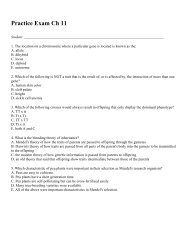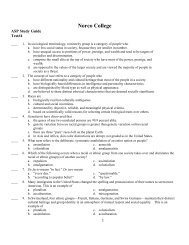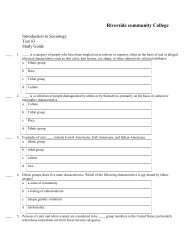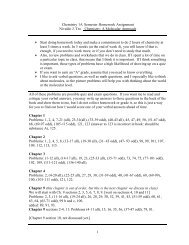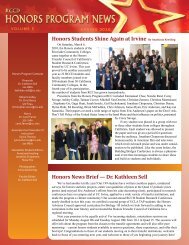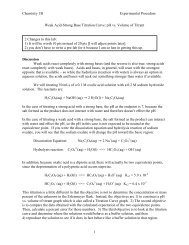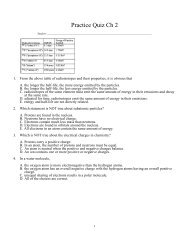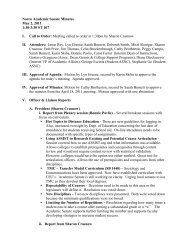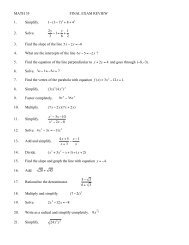1 Hess's Law Lab: Determine the Heat of Formation of Magnesium ...
1 Hess's Law Lab: Determine the Heat of Formation of Magnesium ...
1 Hess's Law Lab: Determine the Heat of Formation of Magnesium ...
- No tags were found...
Create successful ePaper yourself
Turn your PDF publications into a flip-book with our unique Google optimized e-Paper software.
Q excess HCl aqueous soln (surroundings) = -Q Mg+2HCl MgCl2 + H2 (system)Since this is true, <strong>the</strong> next equation is also true:Q soln = m soln c soln T soln = -Q rxn = - (m rxnc rxnT rxn)and som soln c soln T soln = - (m rxnc rxnT rxn)• Calculate <strong>the</strong> heat absorbed by <strong>the</strong> surrounding solution in each trial <strong>of</strong> yourexperiments, and this will also determine <strong>the</strong> change in enthalpy <strong>of</strong> <strong>the</strong> reaction that youjust completed (see <strong>the</strong> equations above).• Then determine <strong>the</strong> molar heat <strong>of</strong> reaction: how much heat would be lost if your startinglimiting reactant were one mole?• Check to see if your two answers are within five percent <strong>of</strong> each o<strong>the</strong>r. Ask <strong>the</strong>instructor if you do not know how to do this.• Check your answers with <strong>the</strong> instructor before doing a third trial to see if you are on <strong>the</strong>right track.Procedure: Part 2The reaction for this part isMgO(s) + 2HCl(aq) MgCl 2 (aq) + H 2 O(l)The procedure is <strong>the</strong> same, but with different quantities <strong>of</strong> materials.Accurately weigh 0.3-0.4 g <strong>of</strong> magnesium oxide metal. Weigh your calorimeter and <strong>the</strong>nadd 30 mL <strong>of</strong> 1 M HCl and reweigh to determine <strong>the</strong> mass <strong>of</strong> <strong>the</strong> acid. While allowingThought Question: The experiment is <strong>the</strong> same, but <strong>the</strong> quantities <strong>of</strong> materials are different.What does this tell you about <strong>the</strong> magnitude (how large <strong>the</strong> number is) <strong>of</strong> <strong>the</strong> heat lost in<strong>the</strong> first reaction compared to <strong>the</strong> heat lost in <strong>the</strong> second reaction?<strong>the</strong> solution to equilibrate, use your spatula to pulverize any lumps in <strong>the</strong> magnesiumoxide powder. Lumps are tightly compacted powder, and this decreases <strong>the</strong> surface area<strong>of</strong> <strong>the</strong> substance available for reaction.Aside: [This is also true in baking. Sometimes corn starch or baking powder is socompacted that most <strong>of</strong> <strong>the</strong> substance doesn’t even react, and so you get tiny white(uncooked) lumps in your cake or pancake or muffins. This is why chefs sift <strong>the</strong> dryingredients, to make sure that all <strong>of</strong> <strong>the</strong> ingredients are fine powders, ensuring that <strong>the</strong>ywill react completely.]2



